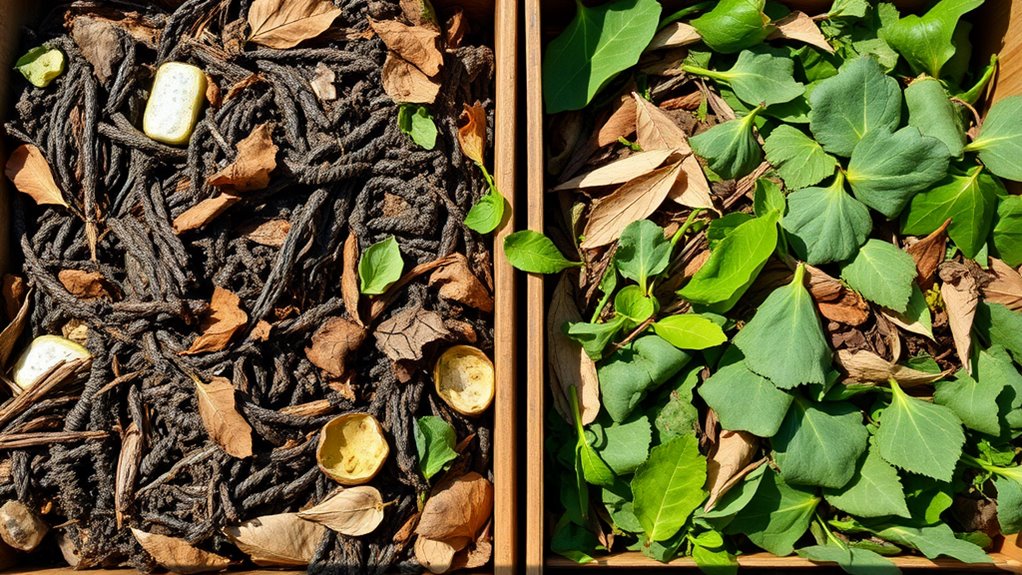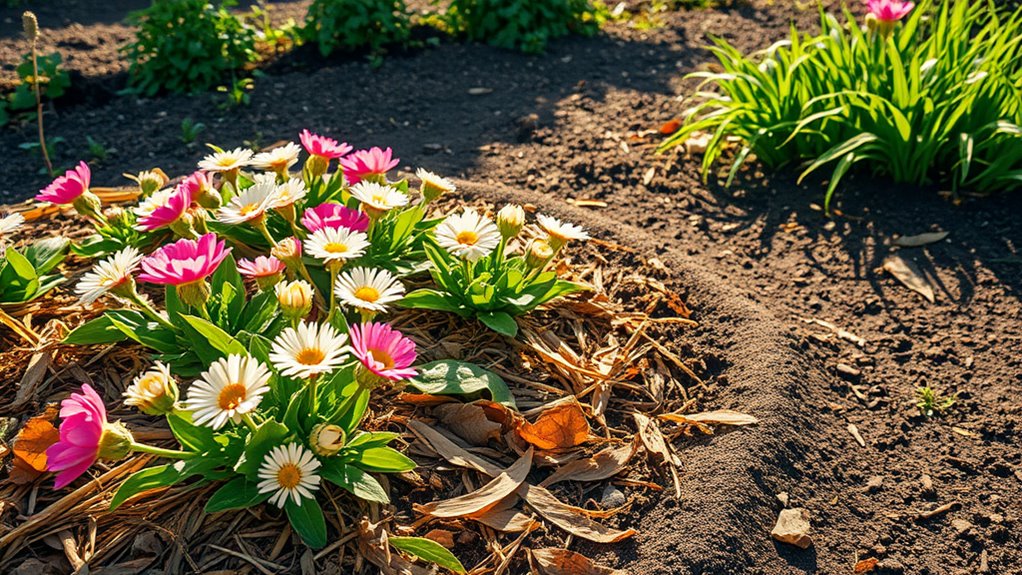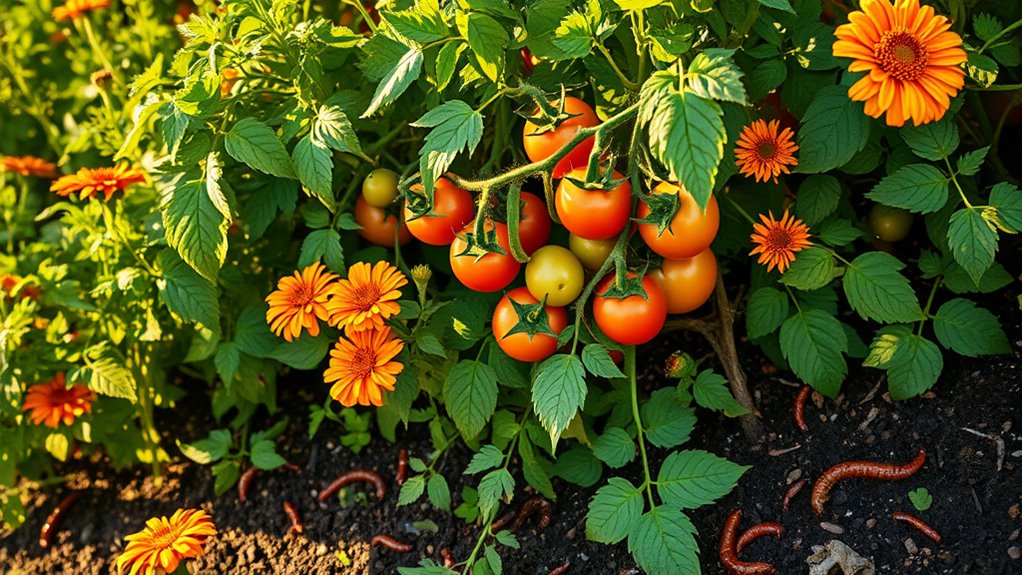Why Your Compost Isn’t Working (And How to Fix It Fast)
If your compost pile isn’t breaking down, it’s likely due to an imbalanced carbon-to-nitrogen ratio, poor aeration, or incorrect moisture levels. You’re probably not turning it enough or adding unsuitable items like oils. Fix it fast by adding greens for nitrogen, browns for carbon, and turning the pile weekly to boost airflow. These tweaks will revive your compost, and you’ll find more strategies to perfect it ahead.
Key Takeaways
- Poor aeration causes odors and slow breakdown; turn the pile weekly to improve oxygen flow.
- An imbalanced carbon-to-nitrogen ratio hinders decomposition; add greens for nitrogen or browns for carbon to reach 25-30:1.
- Excessive moisture leads to anaerobic decay; maintain compost at a damp, wrung-out sponge consistency.
- Low temperatures allow pathogens to persist; mix the pile to raise heat between 130-150°F.
- Overloading creates slimy messes; balance materials, aerate regularly, and avoid non-compostables for quick fixes.
Common Reasons for Compost Failure
Composting can sometimes go wrong, leaving you with a smelly, sluggish pile instead of rich soil.
As shared in lessons from composting mistakes, these errors can be easily prevented with proactive measures.
In composting troubleshooting, common reasons for failure include poor aeration, which suffocates microbes and causes odors, or excessive moisture that fosters anaerobic decay.
You might overlook turning the pile, leading to compaction and slow breakdown.
Pests or contaminants can infiltrate if you add unsuitable items like oils or diseased plants.
To fix this, aerate regularly, maintain moderate wetness, and remove problem materials promptly.
You’ll transform your pile into fertile soil by addressing these issues head-on.
By addressing these common issues, you’ll produce healthy soil enriched with nutrients.
Imbalanced Carbon-to-Nitrogen Ratio
You’ve noticed an imbalanced carbon-to-nitrogen ratio in your compost, which can hinder decomposition and produce odors.
You can add green materials like kitchen scraps to boost nitrogen, or brown materials like leaves to increase carbon.
Start by checking the C:N ratio to determine the right adjustments for optimal results.
This process not only balances your compost but also creates nutrient-rich compost that enhances your garden’s health and sustainability.
Additionally, incorporating kitchen scraps from your kitchen can help recycle organic waste and promote healthier soil in your garden.
Add Green Materials
If your compost pile isn’t heating up or decomposing properly, it could mean the carbon-to-nitrogen ratio is off, so you’ll want to add green materials like grass clippings or kitchen scraps to boost the nitrogen.
These nitrogen-rich items, such as vegetable peels and fresh leaves, fuel the microbes that break down your pile. Aim for a 2:1 or 3:1 carbon-to-nitrogen balance by mixing in greens regularly—chop them for faster decomposition.
Don’t overdo it; too much can make your pile soggy and smelly. Monitor temperature weekly; if it rises, you’re on track.
This simple tweak revives your compost quickly.
Add Brown Materials
On the flip side, an excess of nitrogen in your compost pile calls for adding brown materials to restore balance.
These carbon-rich items, like dried leaves, straw, shredded paper, and wood chips, absorb excess moisture and prevent anaerobic conditions that lead to foul odors.
You’ll boost decomposition by layering or mixing them into your pile, ensuring they outnumber greens by about two to three times in volume.
Chop larger browns for quicker breakdown and turn the pile regularly to incorporate air.
This simple fix creates a well-aerated environment, turning your compost into nutrient-rich gold efficiently.
Check C:N Ratio
Maintaining the right carbon-to-nitrogen (C:N) ratio is essential for efficient composting. You need a balance around 25-30:1 to fuel microbes without overwhelming them.
If your pile’s too carbon-heavy (like with excess leaves or straw), it’ll decompose slowly and smell musty. Conversely, too much nitrogen from kitchen scraps or grass can make it slimy and foul.
Check this by assessing your materials: aim for three parts browns (carbon) to one part greens (nitrogen).
Adjust quickly—add greens if it’s dry and slow, or browns if it’s soggy—to revive your compost and speed up breakdown.
Insufficient Aeration in Your Pile
Is your compost pile sluggish or emitting foul odors? That’s often due to insufficient aeration, where oxygen-starved microbes slow down decomposition. You must turn your pile regularly to introduce air and prevent anaerobic conditions that cause smells and delays. For busy beginners, implementing low-effort methods can help maintain aeration without overwhelming your schedule.
| Sign of Poor Aeration | Cause | Quick Fix |
|---|---|---|
| Foul odors | Compacted materials | Turn pile weekly |
| Slow breakdown | Lack of oxygen | Use a pitchfork |
| Cool temperatures | Inadequate mixing | Add bulky materials |
To enhance your results, incorporate a simple easy composting routine like the one I use weekly to create that nutrient-rich black gold soil for your garden. Fix this now to boost your compost’s efficiency and speed up that rich soil. (112 words)
Moisture Levels That Are Off
If your compost pile feels like a swamp or a desert, you’re likely dealing with off moisture levels that disrupt decomposition. By incorporating kitchen scraps from your kitchen, you can help maintain the ideal moisture for effective decomposition.
Aim for a balance like a wrung-out sponge—moist enough to support microbes but not soggy. If it’s too wet, anaerobic bacteria thrive, causing odors and slowing breakdown; turn the pile and mix in dry materials like straw or shredded paper to dry it out.
For dryness, add water gradually while aerating to rehydrate evenly.
Test regularly by squeezing a handful: it should feel damp without water dripping, ensuring optimal decomposition and avoiding further issues.
For even better results, try simple ingredient swaps to optimize your compost’s moisture and decomposition process.
Temperature Issues in Composting
Temperature directly affects your compost’s decomposition speed, with issues like a pile that’s too cool or overly hot throwing off the microbial balance.
If your pile stays below 90°F, decomposition slows, allowing odors and pests to build—turn it frequently to aerate and generate heat.
Conversely, if it exceeds 160°F, you’re risking beneficial microbes; add water to cool it and mix thoroughly.
Always monitor with a thermometer, aiming for 130-160°F.
You’ll fix these issues quickly by adjusting aeration and moisture, restoring your compost’s efficiency and speeding up breakdown.
Stay vigilant for optimal results.
Incorrect Material Selection
Selecting the wrong materials for your compost pile can quickly disrupt the decomposition process and lead to problems like odors, pests, or a slow breakdown.
For example, you’re likely adding too many nitrogen-rich greens, such as kitchen scraps, without enough carbon-rich browns like leaves or cardboard, throwing off the essential balance.
Don’t include meat, dairy, or greasy items, as they resist breakdown and cause issues. Instead, focus on a 2:1 to 3:1 browns-to-greens ratio, and chop materials into small pieces for faster microbial action.
Test your mix regularly to ensure it’s working, and you’ll restore efficiency swiftly.
Pests and Odors in the Bin
While pests and odors can plague your compost bin when the balance tips, you’re likely dealing with excess moisture or improper aeration, both of which attract flies, rodents, and foul smells. By managing your compost properly, you can also produce nutrient-rich materials that support eco-friendly weed control in your garden.
To combat this, add dry brown materials like leaves or shredded paper to absorb excess water, restoring equilibrium quickly. Ensure better airflow by poking holes or mixing the pile regularly—simple actions that prevent anaerobic conditions.
Monitor your bin weekly; if odors persist, cover fresh greens with soil or finished compost to neutralize scents and deter pests effectively. These tweaks keep your setup thriving.
Embracing these strategies can also incorporate organic gardening hacks to further enhance your overall plant vitality and sustainability.
Poor Pile Maintenance Techniques
Neglecting regular upkeep in your compost pile can quickly turn a productive setup into a problem zone, where issues like uneven decomposition and nutrient loss take hold. You must turn the pile weekly to aerate it, monitor moisture to keep it damp like a wrung-out sponge, check temperatures for optimal breakdown, and balance greens and browns properly. Even in small spaces, these practices can be adapted for effective composting. Here’s a quick guide to fix common pitfalls:
| Poor Technique | Better Practice |
|---|---|
| Infrequent turning | Turn weekly for oxygen flow |
| Neglected moisture | Maintain 40-60% moisture level |
| Unchecked temperature | Keep between 130-150°F |
| Imbalanced materials | Layer evenly for even breakdown |
Adopt these habits to revive your compost efficiently. By maintaining your compost properly, you’re embracing sustainable fertilizing techniques for a thriving garden. (99 words)
Overloading or Underloading the Compost
When you overload your compost pile, it stifles aeration and invites odors, while underloading it slows decomposition by limiting heat and microbial activity.
Overloading creates anaerobic pockets where beneficial bacteria struggle, leading to foul smells and a slimy, unattractive mess that discourages further use. You’ll risk pest infestations and incomplete breakdown as oxygen-starved microbes fail to process materials efficiently.
Underloading, meanwhile, keeps the pile too cool, allowing pathogens to persist and organic matter to decompose sluggishly, wasting your time and resources.
Recognizing these imbalances helps you identify why your compost isn’t performing as expected.
Quick Troubleshooting Steps for Success
To tackle common compost problems effectively, start by assessing your pile’s moisture, temperature, and aeration—adjusting as needed to restore balance.
For moisture, aim for a damp sponge feel; add water if dry, or dry leaves if soggy. If temperature’s low, incorporate more greens and turn the pile regularly.
Improve aeration by forking through the material to prevent odors. Balance greens and browns to maintain the right carbon-nitrogen ratio.
Monitor weekly, avoid non-compostables like meat, and keep the pile in shade. With these steps, you’ll see faster decomposition and healthier results.





